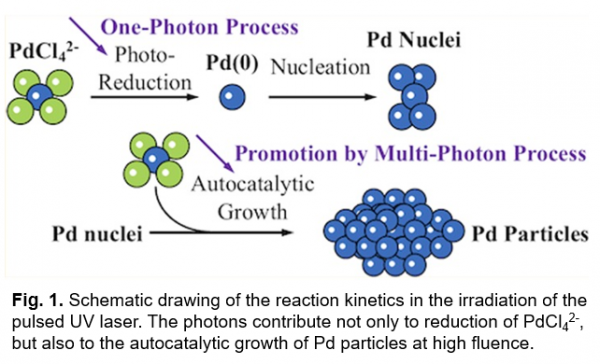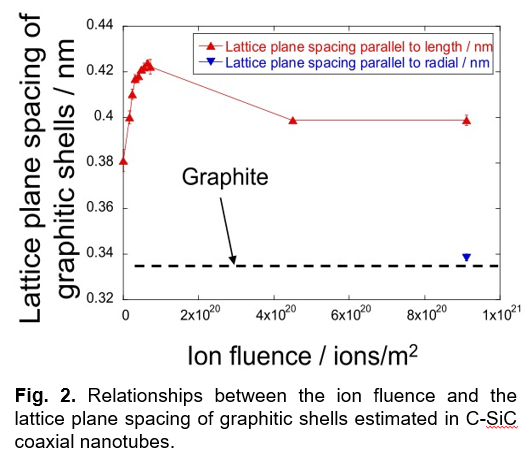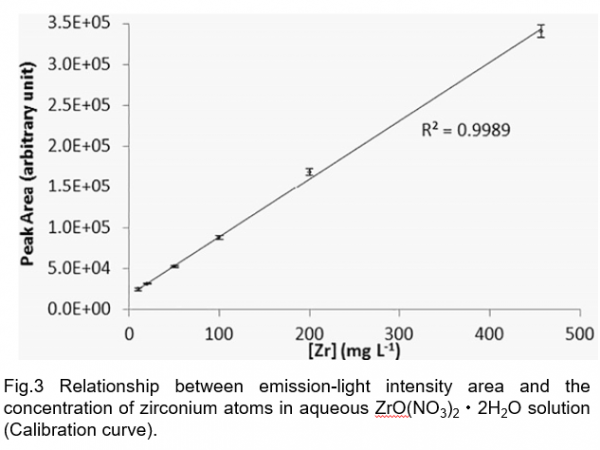Project “Element Separation and Analysis”
Quantum beams are versatile sources for materials processing and analysis. Our project explores basic process of the laser-matter interaction to separate elements from industrial waste liquid or analyze elements under harsh environments, and performs synthesis of novel nanomaterials by ion or electron irradiation. In the former research, we have applied the separation using laser-induced particle formation technique for recovery of precious metals from mixed solution and employed laser-induced breakdown spectroscopy (LIBS) with a unique liquid jet for element analysis. In the latter research, newly structured carbon nanomaterials inside silicon carbide nanotubes have been found. The recent results of our project are introduced as follows.
1.In situ time-resolved XAFS studies on laser-induced particle formation of palladium metal in an aqueous/EtOH solution
The reaction kinetics of laser-induced particle formation in an aqueous/EtOH solution of PdCl42- without a photo-activator was investigated by transmission electron microscopy (TEM) and dispersive X-ray absorption fine structure (DXAFS) measurements. Pd particles were generated by the irradiation of a nanosecond pulsed 266 nm laser with a fluence of 19.9-59.7 mJ/cm2. The TEM observation showed the dependence of the particle size on the laser fluence and the promotion of particle growth by the irradiation of a high-fluence laser. The DXAFS data were analyzed by three methods: (i) deconvolution of the X-ray absorption near-edge structure (XANES) spectrum by a linear combination fitting, (ii) model fitting of the extended XAFS (EXAFS) oscillation of the PdCl42- ion, and (iii) fitting of the spectrum edge of XANES using an error function. These methods give the ratio of Pd2+, the coordination number of Pd-Cl bond, and the edge width of XANES, which are related to the Pd2+ concentration. Temporal changes of the Pd2+ concentration obtained by these three methods were analyzed on the basis of the Finke-Watzky two-step mechanism. The analysis elucidates that, in laser-induced particle formation in the absence of a photo-activator, the photons contribute to reduction of the PdCl42- ion by the one-photon process and to the autocatalytic growth of Pd particles by the multiphoton process as shown in Fig.1.
2.Ion irradiation-induced novel microstructural change of carbon layer in C-SiC coaxial nanotube
A novel hybrid carbon nanomaterial was synthesized by ion irradiation of a C-SiC coaxial nanotube. The hybrid consisted of one-dimensionally stacked graphene nanodisks with diameters less than 50 nm and cylindrical multiwalled carbon nanotubes inside an amorphous SiC tubular layer. A sudden emergence of new continuous graphitic layers in the microstructure were observed by in situ transmission electron microscopy following ion irradiation, where these layers were perpendicular to the nanotube's length direction. The SiC crystals in the C-SiC coaxial nanotube became amorphous, also due to the ion irradiation, although the critical amorphization dose was higher than that for bulk SiC. Most remarkably, the carbon layer remained crystalline, even after an irradiation dose higher than 20 dpa (displacement per atom). Such results show that these carbon layers possess better resistance against amorphization when subjected to ion irradiation than the SiC layers in the C-SiC coaxial nanotube. Figure 2 shows the relationship between the ion fluence and the lattice plane spacing of graphitic shells estimated in C-SiC coaxial nanotubes. The lattice plane spacing of graphitic shells in the carbon layer increased up to the point of irradiation damage demonstrated by the complete amorphization of SiC crystals. The disorder in the carbon layer increased with increasing ion fluence because the induced defects had accumulated. Therefore, the lattice plane spacing of the graphitic shell in the nanotube increased with increasing the ion fluence. Surprisingly, afterward it started to decrease. This demonstrates that the carbon layer experiences high compression stress during ion irradiation. The lattice plane spacing of graphitic shells perpendicular to length is almost the same value as graphite. Thus, the ion irradiation of C-SiC coaxial nanotubes gives rise to a novel development of the microstructure and can be considered as one of the new synthetic processes for making novel carbon nanomaterials.
3.Analysis of zirconium in aqueous solution using laser-induced breakdown spectroscopy technique
Post-accident, Tokyo Electric Power Company Fukushima Dai-ichi Nuclear Power Plant (F1-NPP), the reactors have been filled with water injected for urgent cooling which contains seawater and a part of nuclear fuel debris. It is indispensable to know the content of zirconium in the contaminated water from the viewpoint of the accident analysis for the decommissioning of the nuclear power plant. In the context of the F1-NPP decommissioning process, laser-induced breakdown spectroscopy (LIBS) has many advantages. The purpose of the present work is to demonstrate the on-line monitoring capability of the LIBS coupled with the ultra-thin liquid jet sampling method. The study focuses on zirconium in aqueous solution, considering that it is a major element in the F1-NPP fuel debris that has been subject to only a few LIBS studies in the past.
Using a zirconium mono-element aqueous solution, two regions of interest with many high intensity zirconium lines have been observed around 350 nm in the case of the ionic lines and 478 nm in the case of atomic lines. The best analytical conditions for zirconium are different depending on the analysis of ionic lines or atomic lines. Figure 3 shows relationship between emission-light intensity area and the concentration of zirconium in aqueous ZrO(NO3)2・2H2O solution for ionic line of 349.62 nm (Calibration curve). The curve showed good linearity and correlation. A low limit-of-detection of about 4 mg/L for ionic lines could be obtained, showing that LIBS coupled with the ultra-thin liquid jet sampling technique is a promising alternative for more complex solutions found in the F1-NPP, namely mixtures containing zirconium.



